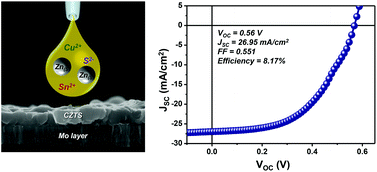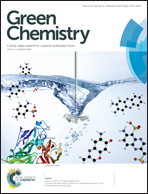Influence of precursor type on non-toxic hybrid inks for high-efficiency Cu2ZnSnS4 thin-film solar cells†
Abstract
Copper zinc tin sulfide (CZTS) has attracted significant attention in the past few years as a next-generation absorber material, and is a promising candidate for the mass production of thin-film solar cells with high efficiencies. Here, we demonstrate a non-toxic solvent-based hybrid-ink approach for the fabrication of a high-quality CZTS absorber layer with a thickness of 1.3 μm and micrometer-scale grains (∼1 μm), resulting in an efficiency of 8.17%. In particular, we investigate the effects of the solid-state Zn metal or ZnS precursor on both the phase transformation and the device performance, which clearly suggests that the low-melting-point Zn phase effectively facilitates the phase-pure, high-performance CZTS absorber layer without the formation of secondary phases that have been observed in most cases of CZTS solar cells derived from wet chemical processes. We believe that our environmentally friendly approach will pave the way toward achieving low-cost, scalable solar cells with high efficiencies.


 Please wait while we load your content...
Please wait while we load your content...